How does a safety clutch work? Big encyclopedia of oil and gas
Big soviet encyclopedia. - M.: Soviet Encyclopedia. 1969-1978 .
See what the "safety clutch" is in other dictionaries:
safety clutch- Protective fittings to protect the wire from damage in case of a possible impact on the fittings. [GOST 17613 80] Linear fittings General terms fittings …
safety clutch- apsauginė mova statusas T sritis automatika atitikmenys: angl. overload coupling; safety clutch vok. Überlastkupplung, f; Sicherheitskupplung, f rus. safety clutch, f pranc. manchon de protection, m … Automatikos terminų žodynas
Safety clutch- 58. Safety clutch Protective fittings to protect the wire from damage in case of a possible impact on the fittings Source: GOST 17613 80: Linear fittings. Terms and definitions original document ... Dictionary-reference book of terms of normative and technical documentation
Coupling for drives to protect the machine from overloads; when the machine is overloaded, the coupling halves disengage or slip... Big encyclopedic polytechnic dictionary
safety clutch with non-breaking link- Safety clutch, in which the shutdown when the nominal value of the torque is exceeded is carried out due to circumferential forces exceeding the frictional forces between the connecting elements and the coupling halves. [GOST R 50371 92] Coupling topics… … Technical Translator's Handbook
safety clutch with breaking link- Safety clutch, in which switching off when the rated torque is exceeded is carried out due to destruction connecting elements. [GOST R 50371 92] Coupling topics Generalizing terms types of mechanical couplings ... Technical Translator's Handbook
triangular tooth safety clutch- Safety clutch with a non-breaking link, which is switched off due to axial forces arising from the transmission of torque on the interacting surfaces of the triangular end teeth of the coupling halves. [GOST R 50371 92] Coupling topics… … Technical Translator's Handbook
safety clutch with shear pins- Safety clutch with a collapsing link, which is switched off due to the destruction of cylindrical pins installed in the coupling halves parallel to the axis of the coupling. [GOST R 50371 92] Coupling topics Generalizing terms types of mechanical couplings ... Technical Translator's Handbook
safety clutch with shear pins- Safety clutch with a breaking link, which is switched off due to the destruction of cylindrical pins installed perpendicular to the axis of the clutch in both half-couplings and having a thinning at the boundary of contact of the half-couplings. [GOST R 50371 92] Topics… … Technical Translator's Handbook
shear key safety coupling- rus clutch (g) with a pivot key, safety clutch (g) with a semicircular shear key eng rolling key clutch, half round key clutch, radial key clutch, rocking key clutch fra embrayage (m) à clavette tournante / pivotante / rotative /… … Occupational safety and health. Translation into English, French, German, Spanish
As safety (slip) clutches, various friction and cam clutches, as well as clutches of a special design, can be used.
Friction clutches
In safety friction clutches the disks are compressed under the action of a spring, the force of which is calculated so that when the torque increases above the permissible value, the disks begin to slip and, with the rotating leading part of the clutch, the driven part remains stationary.
Since the actual value of the friction coefficient can differ significantly from the calculated value, the moment at which the clutch operates can also fluctuate significantly.
Cam clutches
Cam slipping clutches with beveled mechanical cams are similar to the clutches used in the mechanisms discussed above, which open the kinematic chain with increasing torque. The difference lies in the fact that when the torque increases, the kinematic chain does not open and the clutch works like a ratchet, which causes increased clutch wear.
Rice. 13 Safety clutches
Ball Couplings
Of the numerous special designs of couplings, ball couplings are widely used. One of the variants of the ball coupling is shown in fig. 13a. The safety clutch connects the gear 3 with the disk 5. The connection is carried out with the help of balls 4 located in the holes made in the body of the gear 3. The balls also go into the holes of the disk 5. They are pressed against the disk into the balls by springs 6. The tension of the springs, and, accordingly, the value of the transmitted torque, is regulated by means of a nut 1 that moves the plunger 2. When overloading the edges of the holes of the disk 5, the balls are squeezed out and the clutch works like a ratchet.
The force of the springs can be determined in accordance with the method for calculating the cam clutches. elevation angle in this case is the angle between the tangent to the ball and the end plane of the disk 5.
Special couplings
Safety devices with shear pins and keys are used in cases where overloading is rare and occurs only in emergency conditions. As an example of a safety device with a shear pin, a normalized clutch is shown (Fig. 13, b). Hardened bushings 2 and 4 made of 40X steel are pressed into coupling halves 1 and 5. A shear pin 3 passes through the holes of the bushings, which is usually made of the most durable material. When overloaded, the pin is cut off and must be replaced with a new one.
By using a high strength material for the manufacture of the pin, the possibility of accidentally replacing a pin of low strength with a pin of higher strength is eliminated, which could lead to a breakdown of the machine's mechanisms.
- 829 views
These clutches serve to limit the transmitted torque and protect parts of the mechanisms from breakage during overloads exceeding the calculated ones.
Sleeve couplings with shear pin
Coupling dimensions (Fig. 7) take
L = (3…5)d B ,
D= (1.5…1.8)d B
or take from the table. 1.
Rice. 7. Safety sleeve with shear pin
The initial data are:
1. The highest rated torque T nom transmitted by the coupling, N·mm.
2. Estimated torque T of clutch actuation N·mm, in order to avoid accidental activation of the clutch, take T = 1.25T nom.
3. The radius of the cut surface r, mm.
4. Safety pin material: medium carbon steel.
5. Tensile strength (depending on the steel grade of the pin) σ in, MPa.
For calculation from tab. 22 take the proportionality factor K between the shear and tensile strengths.
In the design calculation, d is preassigned for the choice of K.
Estimated pin shear strength, MPa
τ cf = K σ c.
Safety pin diameter (design calculation), mm
Limiting torque, N mm, at which the pin is sheared (verification calculation),

22. Proportionality coefficient K
K values are given for axial pin couplings. In couplings with a radial pin arrangement, the coefficient K should be increased by 5-10%.
Cam, ball and friction clutches
23. Cam, ball and friction clutches
Couplings of general machine-building application are designed to protect the drive from overloads when transmitting torque from 4 to 400 N m, climatic versions: U and TS categories 2-4, UHL and O categories 3.1, 4, 4.1, 4.2 according to GOST 15150 for operation without lubrication ( dry), U and T categories 1-5, UHL and O categories 3.1, 4, 4.1, 4.2, 5 according to GOST 15150 for operation in an oil bath.
Safety dog clutch in accordance with GOST 15620-93
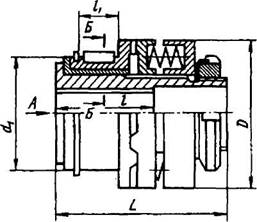
Safety ball coupling according to GOST 15621-77
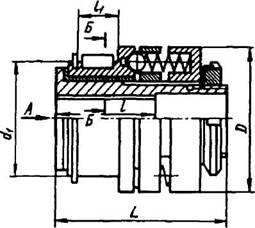
|
General dimensions |
Cam and ball clutch |
|||||||||||
|
Rated torque, Nm |
Weight, kg, no more |
|||||||||||
|
Execution |
Execution |
cam |
ball |
|||||||||
Permissible ratio of actuation torques Тmax/Тnom ≤ 1.3. Couplings are made in three versions:
1 - with a cylindrical mounting hole and a keyway according to GOST 23360-78;
2 - with a slotted mounting hole corresponding to the connection of the middle series according to GOST 1139-80;
3 - with an involute slotted hole according to GOST 6033-80.
Dimensions, mm
Safety friction clutch according to GOST 15622-96

|
dog clutch |
ball clutch |
friction clutch |
|||||||||
|
Weight, kg, no more |
|||||||||||
*GOSTs provide for the 2nd row for execution 1 as less preferable.
GOST 15622-96 provides couplings with torque T up to 16000Nm.
For size b, limit deviations according to GOST 23360-78.
n is the allowed speed.
According to GOST 1b22-96 friction pair material at relative sliding speed: up to 3 m/s - steel on steel; over 3 m/s - bronze on steel.
Permissible pressure on friction surfaces - no more than 0.6 MPa
Springs - according to GOST 13766-86.
Example symbol safety cam clutch with a rated torque of 63Nm, a bore diameter of 25mm, version 1, climatic version U and category 3:
Coupling 63-25-U3 GOST 15620-93.
The same, execution 2 with outer diameter of splines d = 25mm:
Coupling 63-6×21×25×5-U3 GOST 15620-93
The same, versions 3 with a nominal diameter of the teeth of the slots, d= 25mm, module m= 1.5mm:
Coupling 63-25×1.5-U3 GOST 15620-93
23, a. Designation of mounting holes for couplings with straight-sided slots in accordance with GOST 1139-80
Dimensions, mm
|
Designation according to GOST 1139-80 |
Designation according to GOST 1139-80 |
||||
24. Elements of cam safety clutches
The main dimensions of the cam clutches are the same as the main dimensions of the cam clutches (see Table 14).
The edge of the cam, located at an angle of 30 °, is working.
The direction of rotation of the shafts is in one direction, according to the location of the faces.
Strength at the cams:
Dimensions, mm
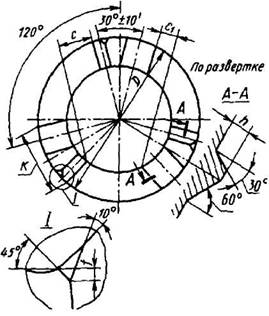
Cylindrical pins according to GOST 3128-70; 1.5×18; 2×18; 3×18; 4×30; 5×30; 6×45; 8×45; 10×45.
Material: bushing-steel 40X, hardness 49.5 HRC; cork-steel 30, hardness 36.5 HRSe.
Spring Cam Couplings
Safety spring-cam clutches (fig. 8) are calculated for contact strength and bending in the same way as clutch cam clutches.
Permissible torque for contact stresses, N mm,
where D is the average diameter of the cams, mm; usually D is selected within 1.25-2.5 shaft diameters;
z is the number of cams;
b – jaw width, mm;
h is the height of the cams, mm;
p - allowable nominal pressure, taken equal to 30 MPa.
Permissible bending torque (determined for cams with flat edges at z > 11)
![]()
where z 1 is the calculated number of cams, equal to 1/2-1/3 total number cams;
[σ and ] - allowable bending stress, MPa, is chosen according to the yield strength with a margin of at least 1.5;
l is the thickness of the cams at the base, cm; with backlash-free clutch:
![]()
where a is the angle of inclination of the working faces, in practice they take no more than 65 °.
The required spring compression force P pr, N, for torque transmission is determined from the following equations:

where T p is the calculated torque, mm; N mm; T p \u003d 1.3T nom (T nom - the highest rated torque);
D is the average diameter of the cams, mm;
a is the angle of inclination of the working faces, degrees;
p 1 - the angle of friction between the cams (for steel 5-6 °);
f 2 - coefficient of friction in a spline (keyway) connection (for steel 0.15-0.16);
d is the shaft diameter, mm.
Formula (1) does not take into account the friction forces in the cams and in the spline connection, which corresponds to the operation of the clutch during prolonged overload. At instantaneous overloads, the action of friction forces is assumed and the calculation is carried out according to formula (2).
For reliable operation of the coupling, the edges of the cams should be rounded off.
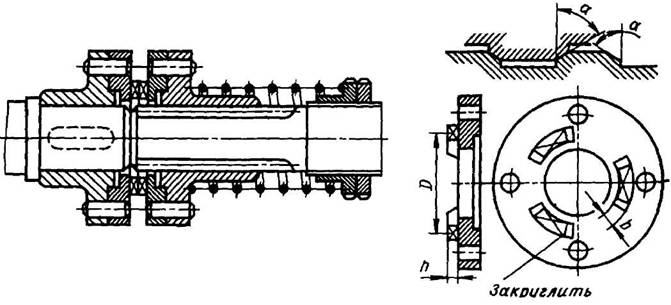
26. Stones for transferring couplings
Dimensions, mm
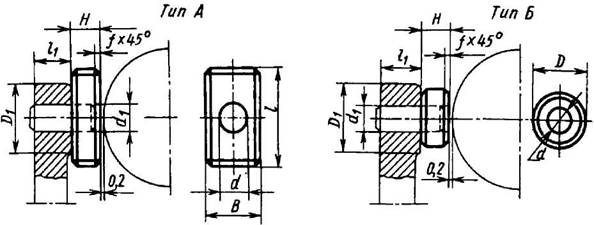
Material:
for type A - SCH20 cast iron, textolite, bronze;
for type B - steel 40X, hardness 49.5 HRCe.
These couplings serve to protect machine parts from the effects of overloads: they separate the shafts when the torque increases above the permissible value.
According to the principle of operation, couplings are distinguished: with a collapsing element; spring-cam; friction.
4.I.I. Couplings with collapsing element
The safety elements of these couplings most often work in shear and in this case are made in the fort of cylindrical pins or in the form of parallel keys. These couplings are simple in design, which led to their wide distribution.
Figure 4.1 (Table 4.1) shows a coupling with a shear pin according to the machine tool normal R 95-1. Both coupling halves are located on the shaft. One half-coupling is connected to the shaft with a key, the other half-coupling sits freely on it, being connected by a key to the part located on its elongated hub.
Rice. 4.1 Coupling with shear pin
The rotation is communicated to the coupling halves through a cylindrical pin 4 located in bushings I and 2. To increase the durability, bushings I and 2 are made of 40X steel with subsequent heat treatment to a hardness of HRC 50...60. When overloaded, the pin is cut off, and the coupling halves freely rotate relative to each other. To facilitate the replacement of the pin on the outer surface of the coupling halves, risks are applied, when aligned, the axes of the holes of the bushings I and 2 coincide.
The pins are made of steel grades U8A, U10A or 40,45,50,
Elements of shear couplings are shown in Fig.42 (Table 4.1).
4.1.2. Friction clutches
These couplings are used for frequent short-term overloads; mainly under impact loads and significant angular velocities and transmit torque due to friction forces.
In Fig.4.2. the safety friction clutch is shown in accordance with GOST 15622-70, and in Table 4.2 its main dimensions and parameters are given.
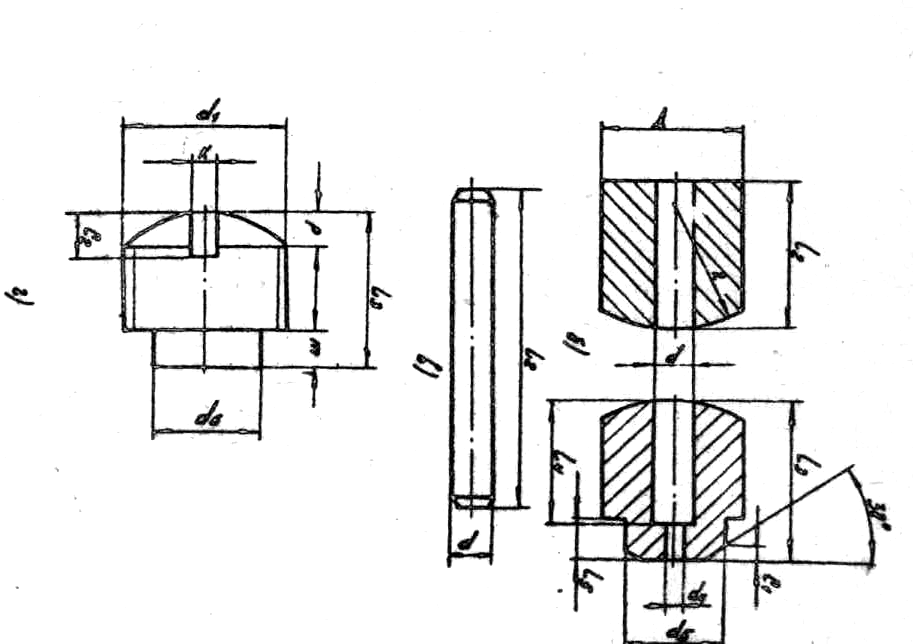
Fig.4.2 Elements of shear couplings
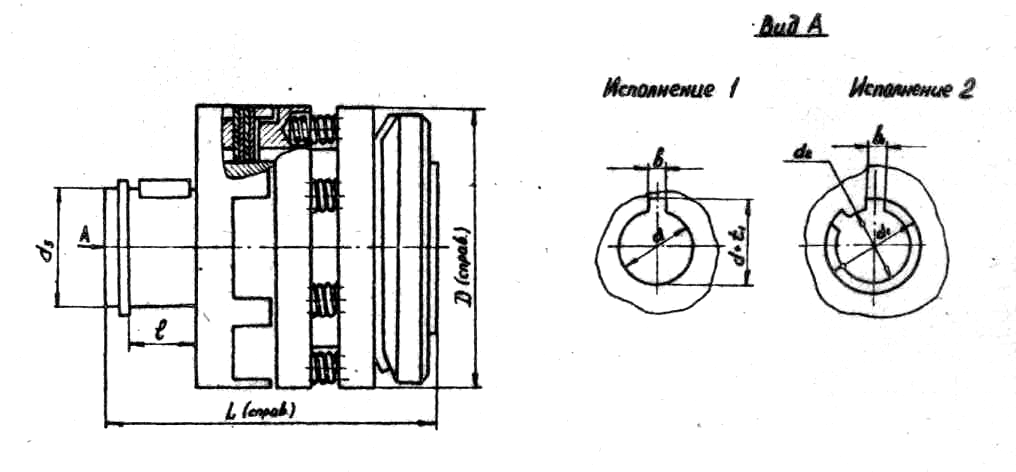
Rice. 4.2 Friction clutch
Table 4.2
Dimensions and parameters of the safety friction clutch (Fig. 4.2)
|
Coupling designation |
[M k ] kgfm |
Dimensions in mm |
|||||||||||
|
Previous off by A |
Landing holes execution1 execution2 | ||||||||||||
An example of a symbol for a coupling with an outer diameter D=50mm and a bore diameter for a shaft d=12mm, version 1: Coupling 1-5012 GOST15622-70
Bore diameter for splined shaft d 2 =11mm, version 2: Coupling 2-5011 GOST 15622-70.
24 November 2011 General information
The working process of many machines and mechanisms is dynamic in nature, accompanied by short-term (peak) load increases. In addition, an increase in the load can be caused by abnormal situations in the operation of the machine: a cessation of lubrication, clogging of the working parts, jamming, etc. Calculation of mechanisms for such maximum loads would lead to unnecessary weight and increase in the cost of the machine. Therefore, design is often carried out on the basis of nominal loads, and safety devices are used to prevent damage to parts during overloads. The functions of the safety link can also be performed by drive elements that allow slippage. So, in hydraulic drives, overloads are prevented by safety valves.
When transmitting torque between the shafts, safety (overload) clutches are used to protect against overloads. Sometimes they are also called torque limit clutches. They are installed in percussion machines; in machines that process a heterogeneous environment; in automatic machines and devices; in branching chains of kinematic chains of machines that transmit a small part of the power of the drive motor (drives for the supply of metal-cutting machines). Since safety clutches cannot eliminate the resulting shaft misalignments, they are often combined with compensating clutches.
Safety couplings according to the principle of operation are divided into: couplings with a collapsing element (not considered); friction ( rice. 1, a); spring-cam ( rice. 1, b); magnetic ( rice. 1, in). Spring-cam clutches have a number of varieties in which the cams are replaced by balls or rollers.
Friction clutches (Fig. 1, a) are the simplest in design. They are used for frequent short-term overloads, mainly shock action.
Friction clutch ( rice. 2) consists of a hub 1 , movable pressure plate 2 , friction linings 3 (asbestos-free!), adjusting nut 4 , locking screw 5 , Belleville springs 6 , plain bearing (sleeve) 7 , rotation encoder 8 (optional), lock screw 9 . Either standardized sprockets or pulleys or a flange are installed between the friction linings. The principle of operation of such a clutch is simple: Belleville springs create an axial force through the pressure ring, pressing the friction linings against the hub and flange (sprocket). When the current moment exceeds the moment of friction, the flange (asterisk) scrolls along the sleeve, which is a plain bearing. By changing the number and relative position of the disc springs, manufacturers get couplings with different transmitted torques. The use of a rotation sensor allows you to control the slippage time of the clutch and reduces the risk of damage.
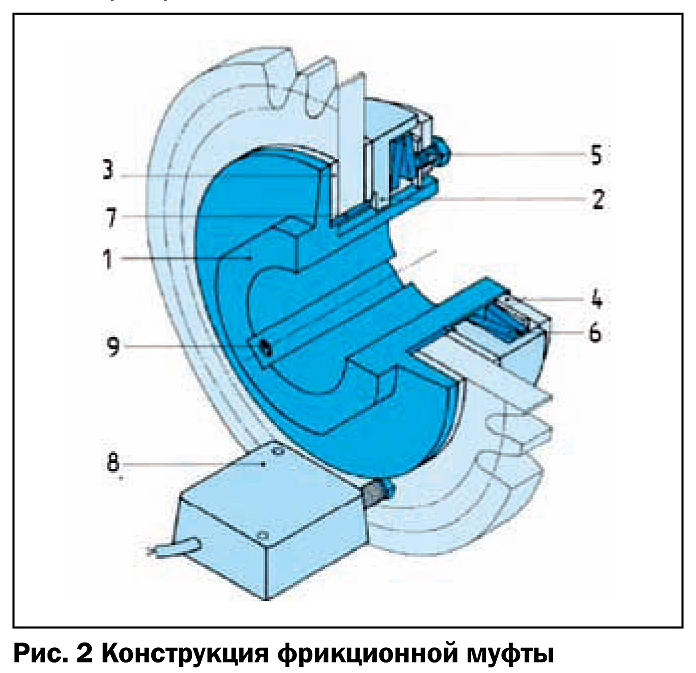
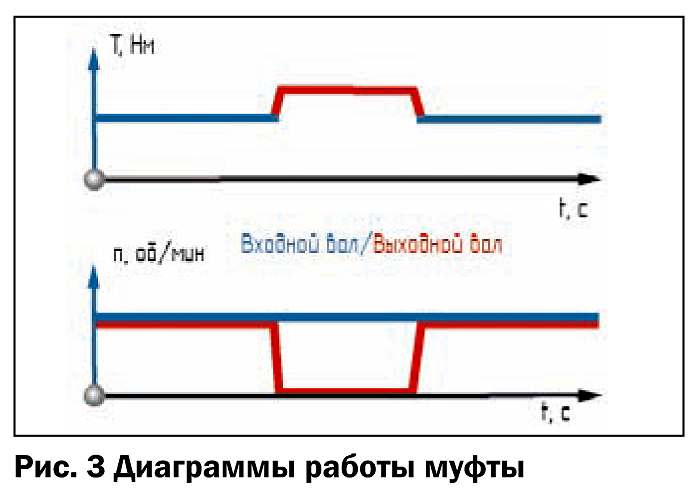
When overloaded ( rice. 3) the clutch slips and the rotation of the output shaft stops. The shaft connection is restored automatically without stopping the transmission of torque during slippage.
Instead of a plain bearing in couplings, a needle bearing is often installed. The use of a rolling bearing is justified with frequent coupling operations, at high sliding speeds, with large radial loads and with high requirements for the accuracy of the relative position of the shaft and the drive element (for example, when installing a gear wheel).
Manufacturers (companies KTR, Mayr, Ringspann) offer couplings with a range of transmitted torque T=2…50,000 Nm with a shaft diameter d=20…200 mm, respectively. An important parameter is the maximum allowable relative slip speed n s , min -1 . As the size of the clutch increases, the speed decreases. So, for a clutch with a shaft diameter d=20 mm, the allowable sliding speed during t S =1 s can reach n S = 8 500 min -1 , and for d=200 mm it decreases to n S = 700 min -1 .
Spring-cam safety clutches ( rice. 1, b) differ from friction clutches increased accuracy tripping, because the elastic properties of the springs are more stable than the coefficient of friction of the friction elements. The advantage of spring-cam couplings of special designs is also the absence of backlash and high torsional rigidity, which is very important in feedback drives (servo drives). However, at high speeds, such couplings are not used, because. subject to repeated overloads due to repeated self-switching. The maximum transmitted moments for these clutches are also lower than for friction clutches.
Spring-cam clutches are divided into cam ( rice. 4, a), ball ( rice. 4, b) and cam-roller ( rice. 4, in). In cam clutches, the working surfaces of the cams are made not flat, but made along a helical line. The processing of such surfaces is technologically complex. Therefore, ball couplings, which are easier to manufacture, are most widely used. In them, the cams are replaced by balls, and sliding friction is partially replaced by rolling friction. Cam and roller clutches use radially mounted rollers that mate with mating grooves.

Spring-loaded ball clutch ( rice. 5) consists of a hub 1 , movable pressure plate 2 , clips with balls 3 , adjusting nut 4 , Belleville springs 5 ,thrust needle bearing 6 , plain bearing 7 and outlet flange 8 . The principle of operation of such a clutch is as follows: Belleville springs create an axial force through the pressure ring, pressing the balls against the sockets in the hub and flange ( rice. 4, b); when the current moment exceeds the permissible value, the balls leave the sockets and the transmission of rotation stops.
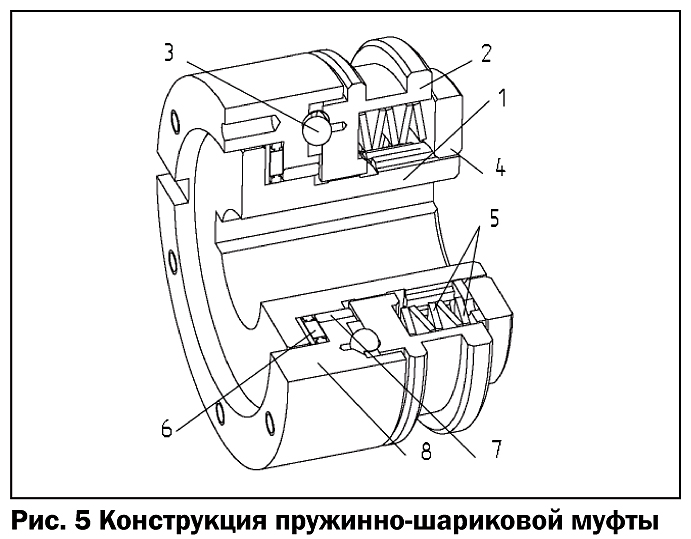
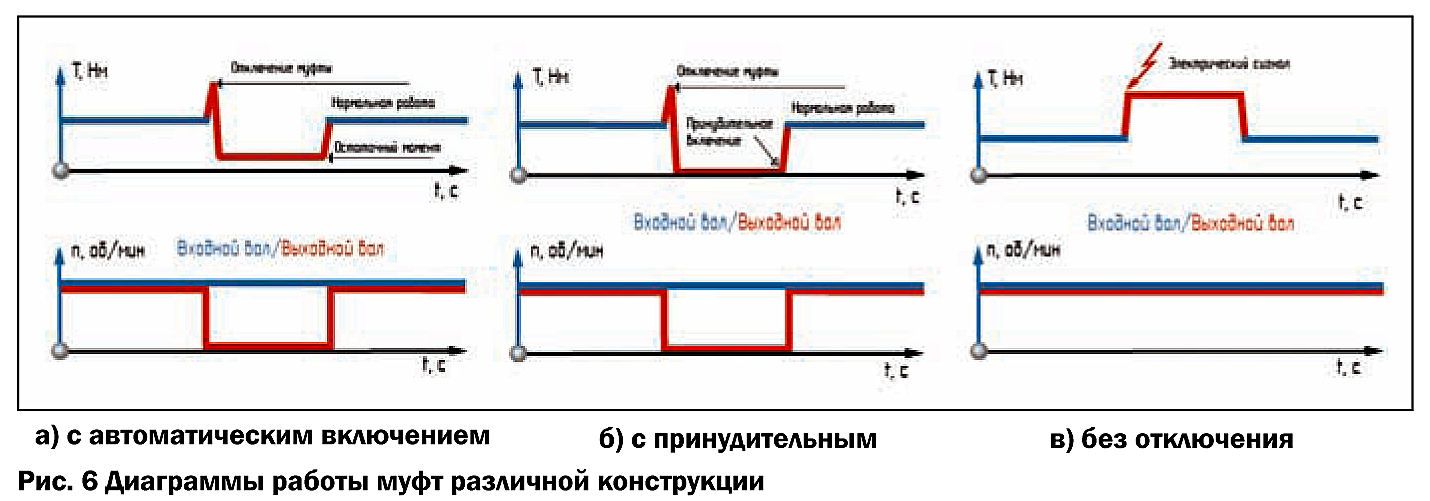
Unlike friction spring-ball clutches have various options restoration of the shaft connection ( rice. 6). When the clutch is actuated, shown in fig. 5 , the rotation of the output shaft stops, however, the residual torque is transmitted to it ( rice. 6, a). The clutch is switched on automatically after the termination of the overload and the rotation of the coupling halves by an integer number of angular steps of the balls.
If a locking mechanism is added to the clutch design between the movable disk and the spring block ( rice. 7), which closes the movable coupling half when actuated, then the restoration of rotation is possible only manually or by an external actuator. A diagram of a clutch with a similar mechanism is shown in rice. 6b.
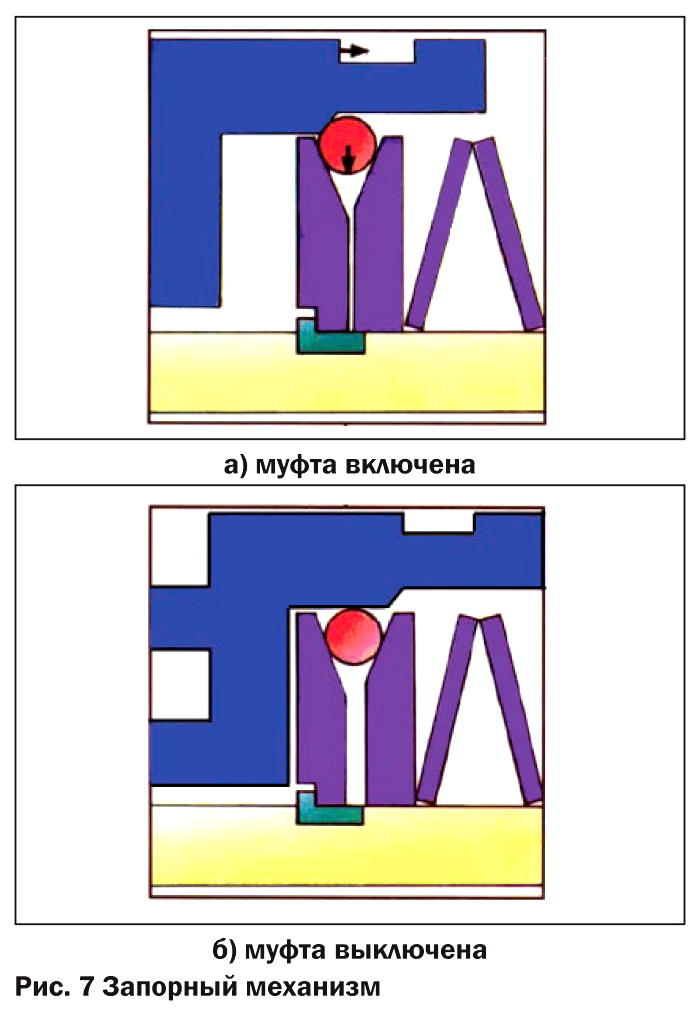
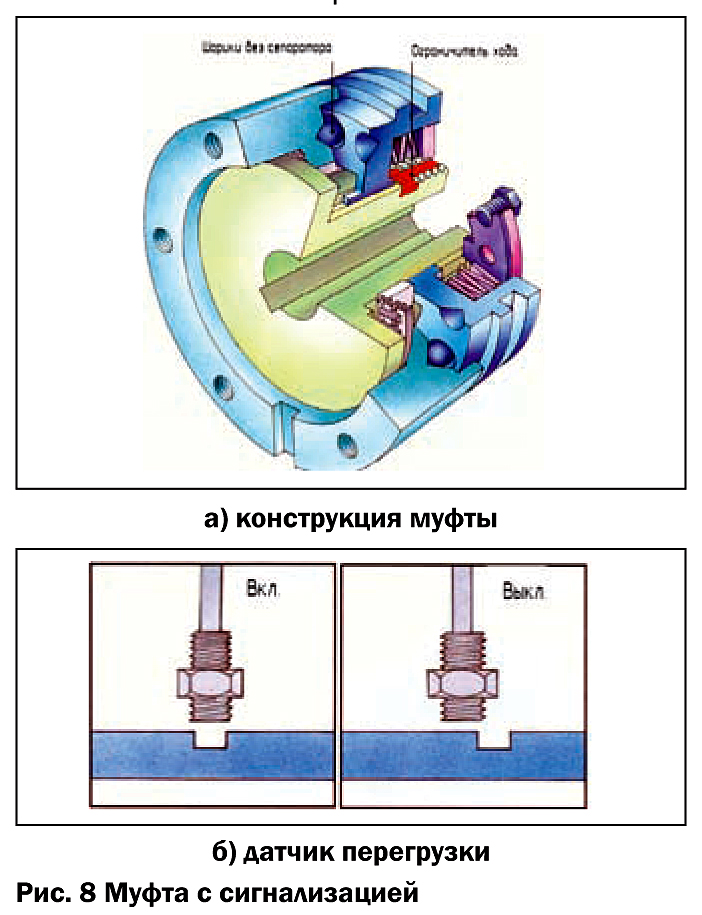
In some designs, such as hoisting machines, interruption of the torque transmission is unacceptable, and an alarm is required in the event of an overload. Then in the basic design of the coupling ( rice. 5) introduce the travel limiter of the movable disk (Fig. . 8, a). When the clutch is actuated, the movable disc moves away from the stationary one until it stops at the limiter. The coupling withstands 4 times the load of the nominal value. When moving, a contactless ( rice. 8, b) or contact sensor. A diagram of the operation of such a clutch is shown in fig 6, c. It should be noted that the trip sensor can be installed in other types of couplings, generating a trip signal.
In the designs of some machines and units, it is necessary to maintain the exact mutual angular position of the driving and driven links. On the basis of the mutual angular position of the shafts, the couplings are divided into ratchet and synchronous. Coupling shown on rice. 5, has a ratchet design.
In a ratchet clutch, after the overload action is terminated, the balls occupy the next free position, and, consequently, the mutual position of the shafts is arbitrary.
On rice. 9 a spring-loaded cam-roller clutch is presented, which only reconnects when the coupling halves are rotated through 360° (45°, 60°, 90° or 180°). This is a synchronous clutch. The principle of operation is similar to the considered spring-ball clutch. A strictly defined mutual position of the shafts is achieved by the uneven angular position of the cams and return rollers ( rice. 4, in). Synchronous design can also be provided with spring-loaded ball couplings ( rice. 11, b, 12, b, 13, b).
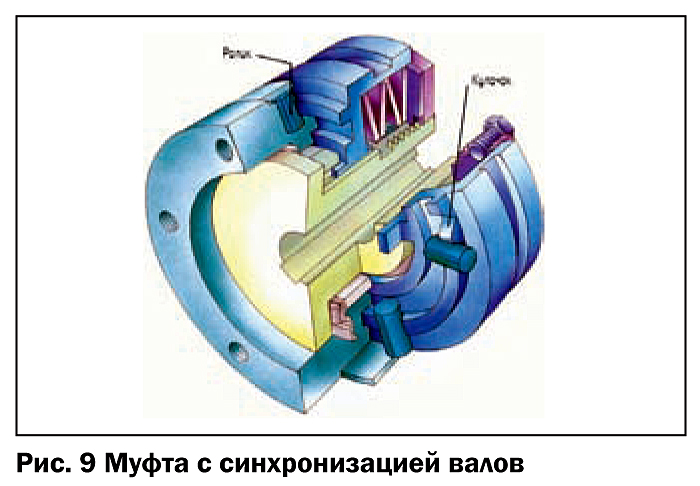
Manufacturers of spring-ball (cam) clutches (firms KTR, Mayr, Ringspann) offer couplings with a range of transmitted torque T=2.5…6,000 Nm with a shaft diameter d=20…150 mm, respectively. For a coupling with a shaft diameter of d=20 mm, the allowable sliding speed for t S =1 s is n S = 4300 min -1 , and for d=150 mm it is reduced to n S =600 min -1 .
In modern machines, systems with a feedback sensor (servo drives) are widely used. Most often, the feedback sensor is installed on the engine (servomotor), and the movements of the driven mechanism are monitored by the number of engine revolutions. For example, it is on this principle that most CNC machines work. However, if the elements located in the kinematic chain after the engine (couplings, gearboxes, etc.) have low torsional rigidity and (or) backlash, then when the load is reversed in the displacement counting system, a discrepancy occurs between the number of revolutions of the engine shaft (taking into account gear ratios) and real values.
To solve this problem, manufacturers offer safety clutches with no backlash ( rice. 11, 12, 13). The absence of backlash is achieved by increasing the accuracy of manufacturing the clutch elements, and, above all, the torque transmission unit. Uniform load distribution between the balls ensures high torsional rigidity. On rice. 10, a shows a comparative relationship between the torque and twist angle of a standard coupling and a coupling with no backlash.
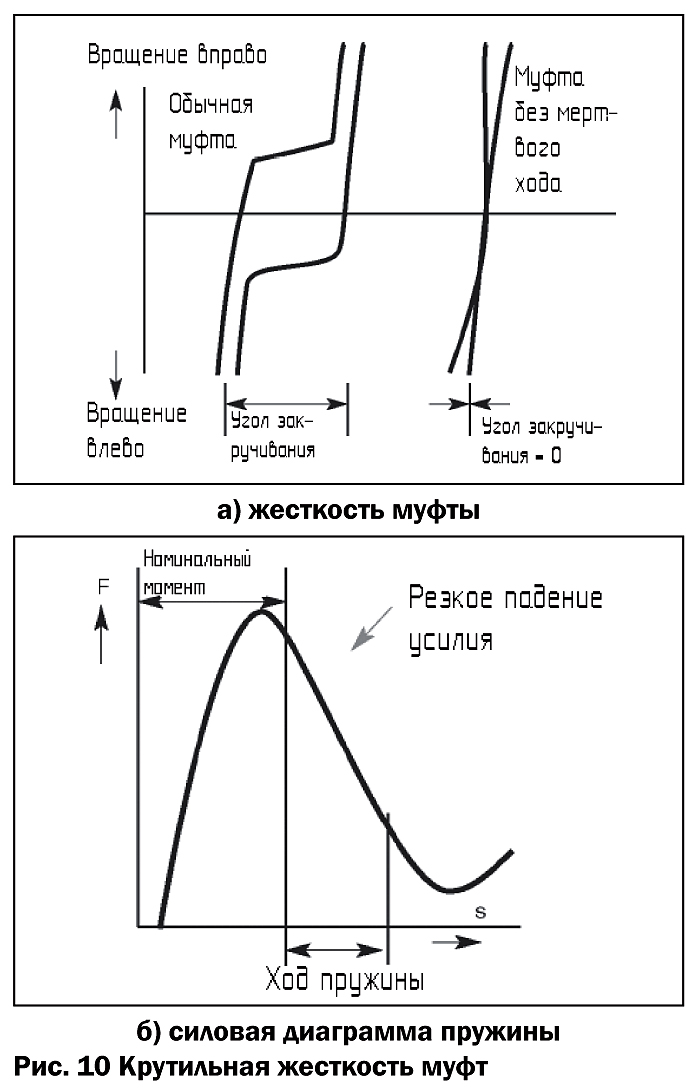
For precision couplings, a belleville spring is often selected so that the operating range of travel falls on the downward branch of the spring force diagram ( rice. 10b). This allows you to increase the speed and accuracy of the clutch.
By design and principle of operation, the couplings with no backlash are similar to the spring-loaded ball couplings described above. On rice. 11 - 13 Couplings of firms are presented Mayr, KTR and R+W with torque transmission units. Couplings have both ratchet and synchronous designs; versions with a locking mechanism; performance without interrupting the transmission of torque from the generation of an electrical signal; can be equipped with a trip sensor.
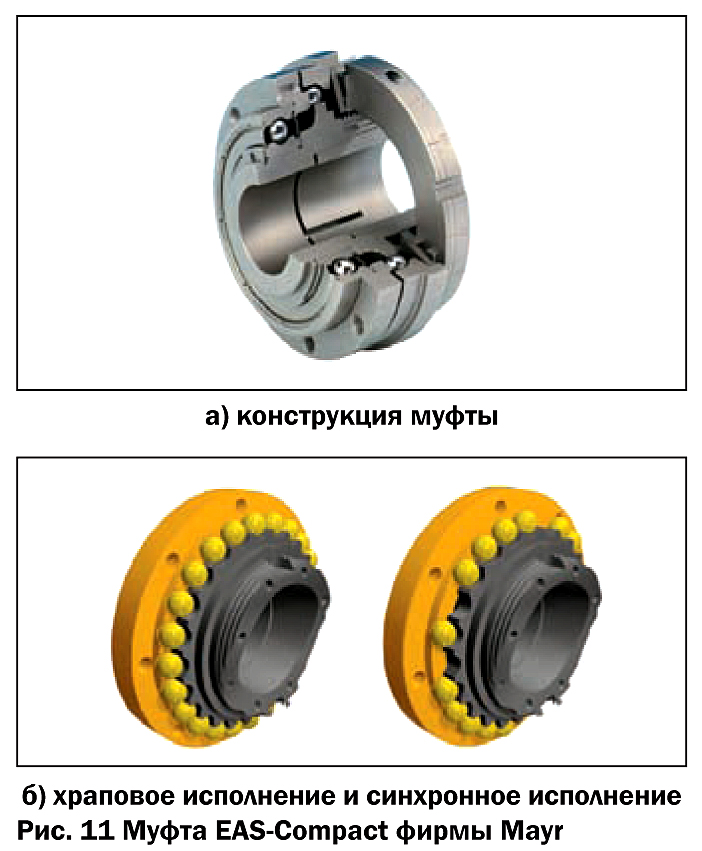
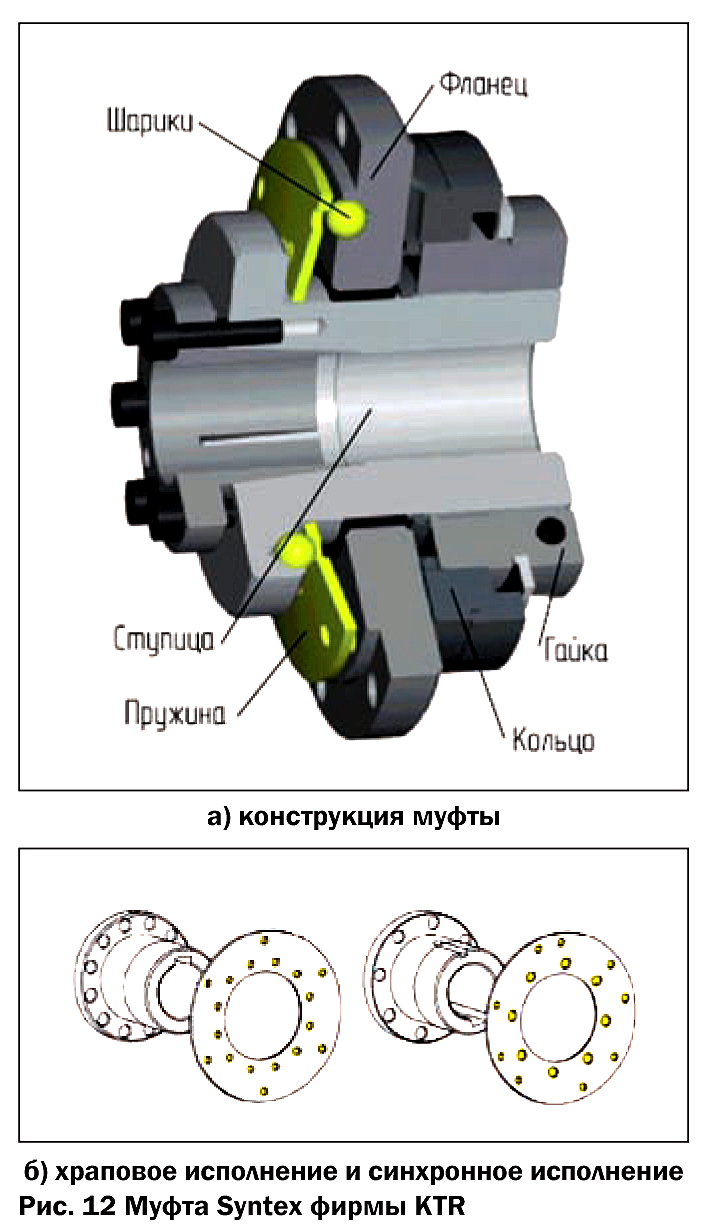

Consider the original design solutions that distinguish backlash-free couplings various manufacturers. In addition to the requirements for accuracy and lack of backlash in servo drives, they strive to reduce the mass moment of inertia (mass) of the driven parts. Reducing the weight reduces the power requirements of an expensive servomotor. In the design of the KTR Syntex coupling (Fig. 12), the torque is transmitted through a special Belleville spring with seats for the balls. Combining the functions of the pressure spring and the movable flange reduces the weight of the torque transmission unit. On the other hand, the manufacturing technology of a special Belleville spring becomes more complicated.
In almost all couplings, in order to increase the running accuracy of the output flange and reduce the overall dimensions of the assembly, the plain bearing is changed to a rolling bearing. In the design of the company's couplings R+W (rice. 13) integrated bearings are used. This reduces the mass of the bearing assembly and the size of the output flange. However, the production technology of the coupling becomes more complicated (the need to make raceways, assembly complexity, etc.)
In addition to the keyed connection, friction clamping hubs are widely used in couplings ( rice. 11 - 13). Their use facilitates assembly with a guaranteed absence of gaps in the coupling-shaft connection. We have already written about the types of clamping couplings and the features of their application (RITM No. 8, 2008)
Safety couplings do not compensate for shaft misalignment. For this, there are compensating couplings. If it is necessary to install two types of clutches in the mechanism, you can purchase a combined clutch ( rice. 14). In the compensating part of such a coupling, couplings are used: elastic with an elastomeric sprocket ( rice. 14, a, b), bellows ( rice. 14, in), gear, disk.

Manufacturers of ball-spring couplings with no backlash offer couplings with a range of transmitted torque T=15…2,800 Nm with a shaft diameter d=4…100 mm, respectively. For a coupling with a shaft diameter of d=4 mm, the allowable sliding speed is n S = 4,000 min -1 , and for d=100 mm it is reduced to n S =250 min -1 .
Prolonged sliding in friction clutches would lead to high wear of the friction surfaces. Therefore, in cases where long-term sliding is necessary, couplings based on the use of liquid or magnetic interaction forces as a transmission link are used. On rice. 1, V the magnetic coupling on permanent magnets is presented. The coupling consists of a hub with permanent magnets; output flange resting on a rolling bearing; a sleeve with a magnet screwed onto the output flange, a locking screw. By screwing or unscrewing the sleeve, you can change the transmitted torque. There are no rubbing elements in the clutch.
The clutch operation diagram is shown on rice. 15. As can be seen from the figure, a constant torque always acts on the output shaft, and the output shaft revolutions fall when overloaded. When the clutch slips, heat is generated. The allowable sliding time and speed depend on the thermal conditions of the coupling.
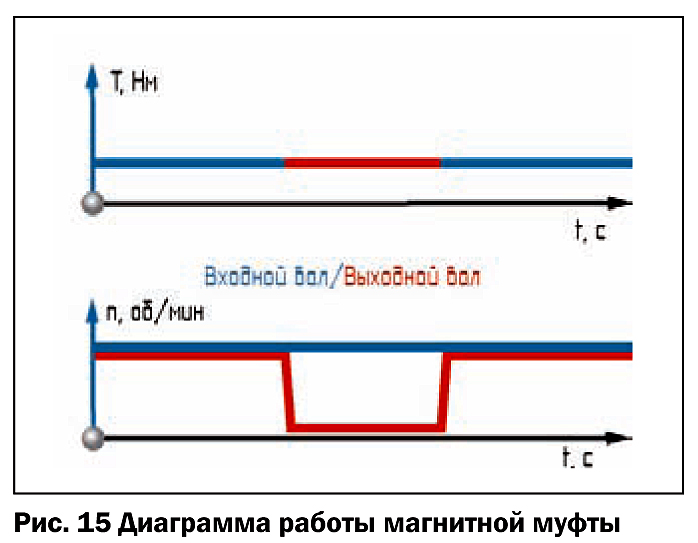
Firm Mayr, presented on our market, offers magnetic couplings with a range of transmitted torque T = 0.1 ... 6 Nm with a shaft diameter of d = 10 ... 38 mm, respectively. For a coupling with a shaft diameter of d=10 mm, the allowable sliding speed is n S = 4000 min -1 , and for d=38 mm it is reduced to n S =3000 min -1 . The scope of such couplings is limited (test equipment, control mechanisms, etc.).
Installation of couplings
In the kinematic chain, it is recommended to place the safety clutch directly on the shaft that drives the actuator ( rice. 16). In this case, all mechanisms in the circuit are protected from overloads.
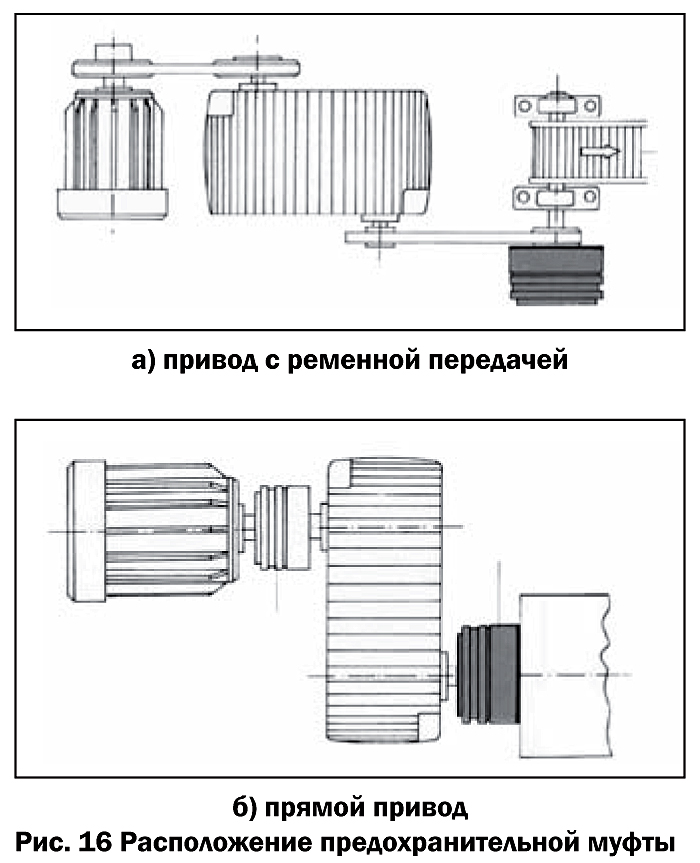
However, in most cases, the torque on the actuator is significantly higher than on the motor. Accordingly, the size and price of the coupling increases. On rice. 16b shows an alternative placement of the coupling. In this case, the gearbox must withstand peak overloads.
Very often, safety clutches are combined with a pulley (sprocket) of belt (chain) drives or a compensating clutch. When designing an assembly with a safety clutch, it should be remembered that not all clutches require the installation of transmission elements directly on the output flange. On rice. 17, and the installation of a safety clutch on the output shaft of an electric motor with a belt drive pulley is shown. The pulley is mounted on a separate rolling bearing. On rice. 17b the design of the safety clutch with a long hub is presented, designed to install a pair of sprocket bearings of a three-row chain.
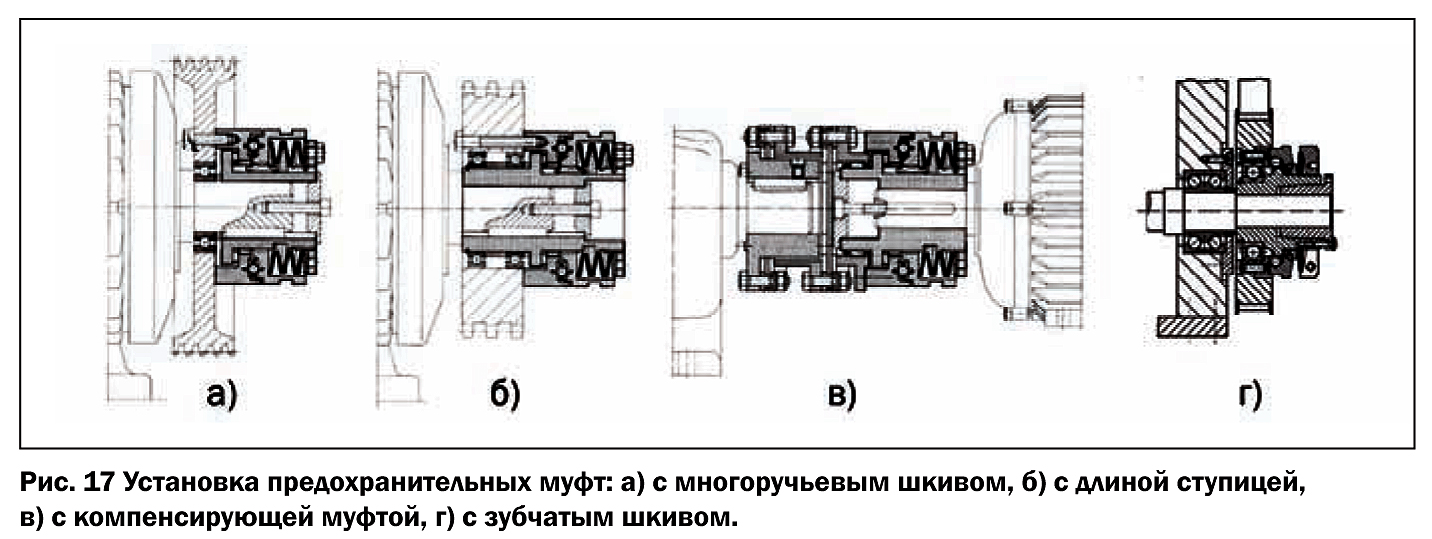
In the case of the combination coupling shown in rice. 17, in, the leading coupling half of the compensating part is mounted on a needle bearing. Couplings on rice. 2 and 17, d allow you to install an asterisk or toothed belt pulley without additional supports.
Calculation sequence
On rice. 18 under the number 1 a graph of the actual operating moment in an arbitrary mechanism is presented. Numeric 2 the limit of the maximum value of this moment is indicated. The nominal moment of the coupling T N, Nm is recommended to be taken 30 ... 50% more than the maximum moment that occurs during operation (indicated by the number 3 ).
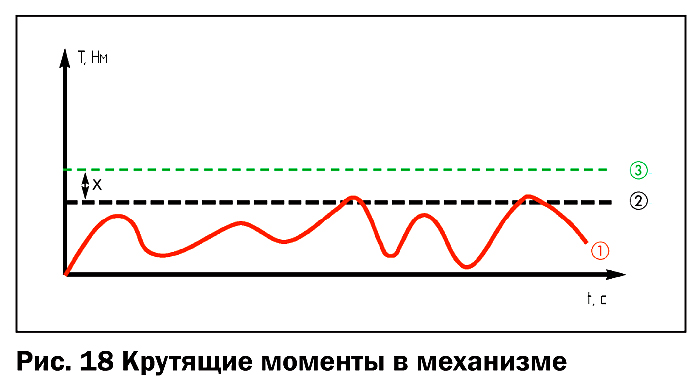
Conclusion
Incorporating safety clutches into the design reduces the cost of the machine (due to downsizing) and the cost of operation (due to increased reliability). The designs of the couplings offered on the market are diverse and can satisfy any designer's requirements. It remains only to choose and remember that " The only problem with choice is that it exists.».
Mikhail Grankin
RITM magazine, February 2009



